The historical churches of Isfahan are among the most fascinating attractions of the city. According to history during the reign of Shah Abbas I of the Safavid dynasty, a group of Armenians migrated to the Jolfa district of Isfahan to prevent the destruction caused by the Ottoman invasion (which had reached these areas in pursuit of Shah Abbas). Over time, these Armenian immigrants settled in the region and built various churches to hold their religious ceremonies, which now stand as historical churches with unique splendor in the city of Isfahan.
Book Iran Air flights from London to Tehran and Tehran to London with Eligasht UK:
An Attraction of Isfahan’s Historical Churches
Like other historical attractions, churches also hold numerous stories from the past within their walls. Nowadays, in the heart of Isfahan, there are historical churches that were once safe havens for some. Each of these historical churches has its own distinct story.
The Famous and Historical Vank Church of Isfahan
The Jolfa historical district should be considered a sanctuary of ancient heritage and national treasures, with its magnificent architecture, captivating decorations, and exquisite paintings captivating the heart of Isfahan and contributing to the historical identity and tourist attractions of Iran. Among all these picturesque attractions, it must be said that Vank Church is undoubtedly the flagship of all the historical churches of Jolfa, Isfahan. It is a valuable pearl that carries an interesting and captivating story behind its name. Not only does it hold a significant historical and cultural position for our country, but it also has a special religious significance for the Armenian community in Iran.
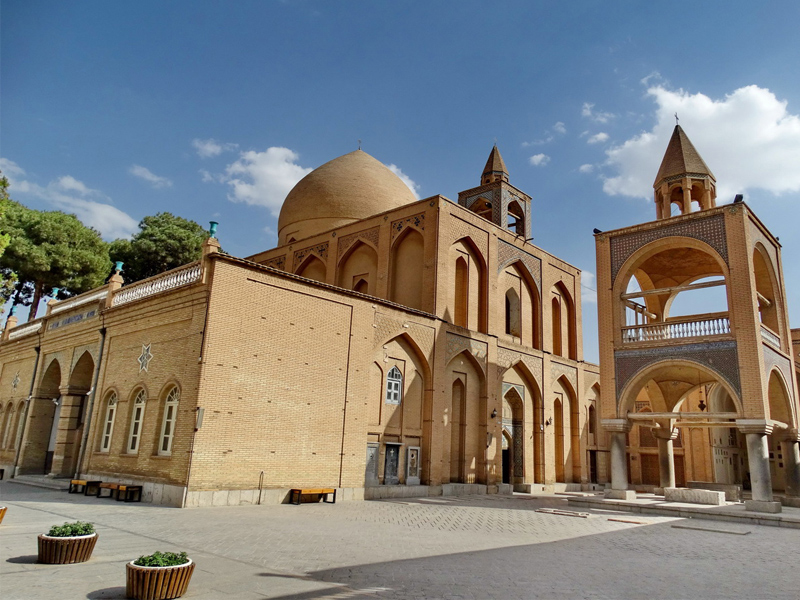
History of Vank Church
Vank Church is one of the historical Armenian churches in Isfahan. It was built by order of Shah Abbas II and with the efforts of the Armenian community of the city. The name “Vank” is derived from a church in Nakhchivan called “Amenaprkich Vank Goght” or “Holy Savior Church.”
Initially, Vank Church was just a small building in the southwestern part of the current structure, known as “Koup Church.” After approximately 50 years of the construction of this small church, new construction began to create what we now know as the historical Vank Church. The current building of Vank Church was built in 1655 AD.
The Bell Towers of Vank Church
One of the fascinating parts of the historical Vank Church of Isfahan, which you can see after entering the church on the right side, is a tall tower called “Bell Tower One” or “Clock Tower.” This tower is built on three levels. On top of this tower, just below the third level, you can see a very large clock. The clock of this tower was added approximately 38 years after the construction of the main building of Vank Church. Bell Tower One was built by Mardis Hontanian, one of the Armenian architects.
Bell Tower Two: Another one of the bell towers of the historical Vank Church is located on top of the roof, amidst the western wall and a small dome. Bell Tower Two has a square shape and covers an area of 8 square meters. At the intersection of the sides of this square tower, there is a raised brick column that reaches a height of 3 meters.
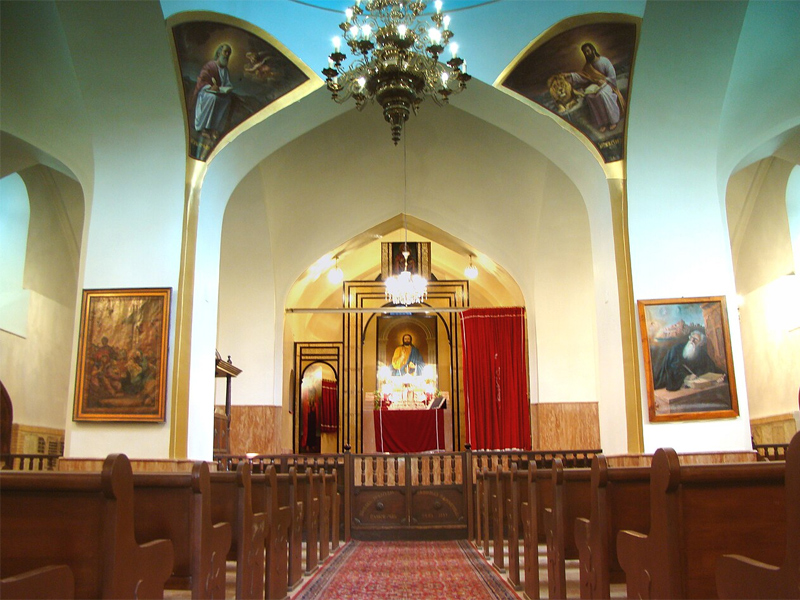
Inscriptions of Vank Church
In the historical Armenian church of Isfahan (Vank Church), four inscriptions are placed in different parts of this historical structure. Three of these inscriptions have texts written on them.
- First Inscription: You can see the first inscription of this historical church on top of its entrance. A sentence is written on this inscription that reveals the age of this church.
- Second Inscription: You can find another inscription of the historical Vank Church at the entrance door on the western side of this historical building. This inscription is made of tiles and its color is turquoise. On this inscription, a text remains in golden letters. In this text, the start time of the construction of the church, its builder, and the end time of the construction of Vank Church are specified.
- Third Inscription: You can see the third inscription of the historical Vank Church in the entrance section of Bell Tower One. This inscription is made of marble. On this inscription, you can also see text about the builder of the clock tower, the construction time, and the reason for its construction.
- Fourth Inscription: You can see the fourth inscription of this historical church on the right side of Bell Tower One. This inscription is blue and covered with cross-shaped stones. These stones are called “Khach Klim” in Armenian. This is the only inscription of Vank Church that does not have any text written on it.
Related post
Ali Qapu Mansion, the Gateway to the Splendid World of Safavid
10 of the Most Famous Ancient Baths in Iran
Paintings of Vank Church
One of the most beautiful and captivating parts of the historical Vank Church is its paintings. If you are interested in art and painting, the details and color combinations of the ceiling and walls of this church will surely mesmerize you. Even if you simply have an appreciation for art, the beauty of the interior wall paintings of the historical Vank Church in Isfahan will be so captivating and enchanting that you will be entranced by them for several minutes.
Almost in every part of this church, you can find beautiful and colorful paintings. These paintings exist on the walls, the interior of the dome, the arches, and even outside the church. They are painted on stone, wood panels, canvas, and walls. Many of these paintings depict stories from the Christian Bible. From the birth of Jesus Christ to his ascension, from purgatory to heaven and hell, you can witness these beautiful and colorful stories on the walls and ceiling of this historical church.
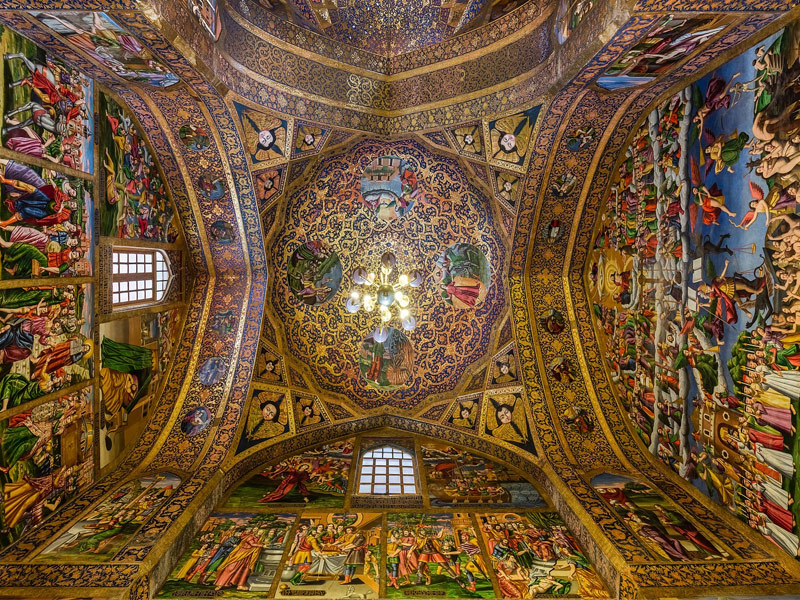
The Most Attractive Painting of Vank Church in Isfahan
One of the most attractive paintings in the historical Vank Church is a narrative painting that starts from a dedicated room in the church and tells various stories. These images continue throughout the church. In these paintings, the story of the birth of Jesus Christ, the Last Supper, his crucifixion, burial, and several other religious stories are depicted.
Historical Saint George Church of Isfahan
George Church, also known as Khajeh Church, is one of the most notable historical churches in Isfahan. According to historical documents found on the inscriptions within the church, this historical building was constructed in 1611 AD by a renowned merchant from Jolfa named Khajeh Nazar.
An Account of This Historical Church
It is narrated that Shah Abbas I of the Safavid dynasty made continuous efforts to keep the Armenians in Isfahan. Being aware of the religious beliefs of the Armenians, he issued an order to demolish the “Echmiadzin Church,” a significant Armenian church in the world. After the destruction of Echmiadzin Church, several pieces of stone, including the altar, were separated and transferred to the current historical Saint George Church.
These stones were placed in various parts of the church, such as in front of the altar, the northern courtyard, and so on. After that, the historical George Church of Isfahan became a pilgrimage site for Armenian Iranians. This Armenian church in Isfahan holds a special place among Armenians. The narratives about the miracles of Saint George have made this place one of the important pilgrimage sites for Armenians. This church is only a five-minute walk (300 meters) away from the famous Vank Church.
Historical Bethlehem Church in Isfahan
The Bethlehem Church, also known as “Betqahm,” can be considered one of the oldest churches in Isfahan. The Bethlehem Church was built by a renowned merchant named “Khajeh Petros Velijanian,” and you can now see his image on the church wall.
Most of the time, the sound of the church choir can be heard from the interior of Bethlehem, which adds to the spiritual and mystical atmosphere of this place. The paintings on the dome and interior walls are inspired by events from the Bible.
It is interesting to note that Khajeh Petros Velijanian and several members of his family are buried in the courtyard of this church.

Historical Church of Mary and Holy Hakob in Isfahan
According to historical documents, the Hakob Church (Church of Saint James) claims the title of the oldest historical church in Isfahan. This church, dating back to 1607 AD, is located alongside the Church of Maryam Magdalya. The Hakob Church, with its adobe façade, had a cross-shaped design in 1607. However, after the destruction of a part of the church, its cross-shaped design was lost. People hold great respect and attention for the Hakob Church as the first church built in Julfa.
The relatively small Hakob Church did not have enough space to hold religious ceremonies. With the rise of Safavid construction projects in the city of Isfahan, the Church of Maryam Magdalya was built near the Hakob Church with the help of an Armenian nobleman.
Historical Church of St. Stephanos, Isfahan
The St. Stephanos Church is one of the largest historical churches of Isfahan, located in the Hakobjan neighborhood of Isfahan. Two small domes are placed on either side of the main dome of this church, and there are also eight skylights in the church. Unlike churches like the Holy Mary Church, St. Stephanos Church does not have many paintings. The mihrab (prayer niche) of St. Stephanos Church is located in the eastern section, the bell tower in the northeast section, and a prayer room called the Holy Mary Prayer Room in the southern courtyard of the building. Materials such as bricks and adobe were used in the construction of this historical structure. It is interesting to note that there is also a church with the same name (St. Stephanos Church) in Azerbaijan.
Historical Church of Hovhannes, Isfahan
This church, like many historical churches in this city, is a relic from the Safavid era. The beautiful name of this church is derived from the name of one of the disciples of Jesus (John). This church has a very good geographical location, which is why it attracts many tourists from around the world every year. Fortunately, the Church of Hovhannes Megerdich, or St. John’s Church in Isfahan is one of the historical churches that has remained preserved from the damages caused by time, and therefore it still sees a lot of activity, just like before. The artistic design and construction of this building were carried out by French and Russian architects. However, over the years, the Church of Hovhannes has undergone several repairs and restorations, so its appearance may have changed slightly compared to its original state.
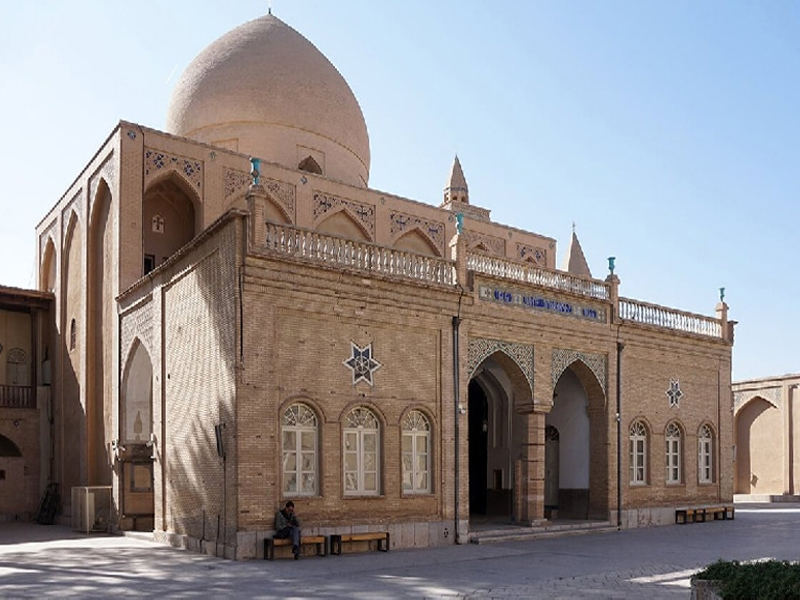
Historical Church of Nerses, Isfahan
The Holy Nerses Church or “Surp Church” is another historical church in Isfahan, located in the Koocher neighborhood (Sangtarashha Street). This church was built as a memorial for a person named “Ootik Dilanian,” but after the placement of gifts associated with the Holy Nerses, the name of this historical church changed to the Holy Nerses Church. The Baghous Church (Protestant Church of Isfahan) and the Holy Mary Catholic Church are also located near this church.
Historical Church of Katarineh, Isfahan
The “Katarineh Church,” also known as the “Katarinian Church,” was built in 1623 AD by the order of a famous and wealthy merchant named “Khajeh Yaghiazar Laghzarian.” This church served as a monastery for nuns. The Katarineh Church had various sections, including a kitchen, a dining hall, classrooms, and living quarters.
Over the years, this historical church in Isfahan, like other historical buildings in Isfahan, required restoration. In 1842 AD, a person named “Hakoup Petrosian” took charge of the restoration of this church and added a large hall to the original structure.
Final words
The historical churches of Isfahan stand as magnificent testaments to the city’s rich religious and architectural heritage. These sacred structures, built during the Safavid era and beyond, have withstood the test of time, preserving their beauty and significance for centuries. In general, there are numerous historical churches in Isfahan, especially in the Jolfa neighborhood of Isfahan, where there are many churches, most of which were built during the Safavid rule. Currently, the doors of churches like Vank are still open to enthusiasts, allowing them to visit for prayer, worship, and sightseeing. Visiting these historical churches offers a glimpse into the vibrant religious and cultural landscape of Isfahan, inviting us to appreciate the beauty of their architecture and the resilience of the communities they have served.
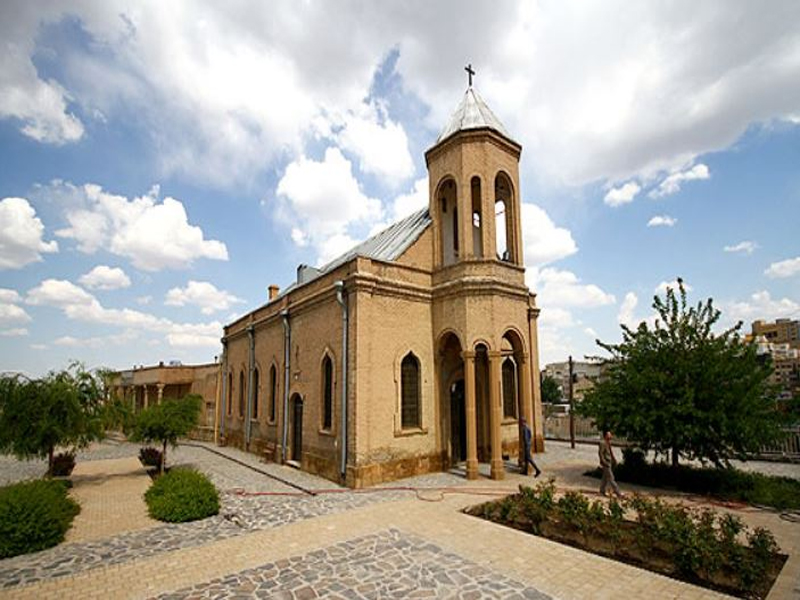
FAQ
1- What are some famous historical churches of Isfahan?
Isfahan is home to several notable historical churches, including the Vank Cathedral, the Church of Saint Joseph, the Bethlehem Church, and the Church of Saint Mary.
2- When were these historical churches in Isfahan built?
The Vank Cathedral, also known as the Holy Savior Cathedral, was constructed in the 17th century, while the Church of Saint Joseph dates back to the 19th century. The Bethlehem Church and the Church of Saint Mary were built in the early 17th century.
3- What architectural features can be found in these historical churches?
Isfahan’s historical churches showcase a blend of architectural styles. The Vank Cathedral, for example, exhibits a combination of Armenian and Persian influences, featuring intricate frescoes, ornate tile work, and a stunning dome. The Church of Saint Joseph displays a more traditional European architectural style, with its grand entrance and bell tower. The Bethlehem Church and the Church of Saint Mary also boast unique architectural elements, such as decorative arches and beautiful interior decorations.

